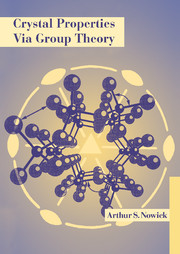Book contents
- Frontmatter
- Contents
- Preface
- 1 Tensor properties of crystals: equilibrium properties
- 2 Tensor properties of crystals: transport properties
- 3 Review of group theory
- 4 Linear relations treated group theoretically
- 5 The magnetic point groups and time reversal
- 6 Matter tensors of rank 0, 1 and 2
- 7 Matter tensors of rank 3
- 8 Special magnetic properties
- 9 Matter tensors of ranks 4 and 5
- 10 Matter tensors of rank 6
- Appendices
- A Review of tensors
- B Stress, strain and elasticity
- C Finite deformation
- D The great orthogonality theorem
- E The Symmetry-Coordinate Transformation tables for the 32 point groups and two infinite groups
- F Proof of the Fundamental Theorem
- G Theorems concerning magnetic groups
- References
- Index
Preface
Published online by Cambridge University Press: 18 December 2009
- Frontmatter
- Contents
- Preface
- 1 Tensor properties of crystals: equilibrium properties
- 2 Tensor properties of crystals: transport properties
- 3 Review of group theory
- 4 Linear relations treated group theoretically
- 5 The magnetic point groups and time reversal
- 6 Matter tensors of rank 0, 1 and 2
- 7 Matter tensors of rank 3
- 8 Special magnetic properties
- 9 Matter tensors of ranks 4 and 5
- 10 Matter tensors of rank 6
- Appendices
- A Review of tensors
- B Stress, strain and elasticity
- C Finite deformation
- D The great orthogonality theorem
- E The Symmetry-Coordinate Transformation tables for the 32 point groups and two infinite groups
- F Proof of the Fundamental Theorem
- G Theorems concerning magnetic groups
- References
- Index
Summary
The study of the anisotropic properties of crystals, often called ‘Crystal Physics’, is the oldest branch of solid-state physics, dating back to the turn of the twentieth century and the treatises of W. Voigt. It deals with the ‘matter tensors’ that describe such anisotropic properties, and the way that these tensors are simplified as a result of the existence of crystal symmetry. In recent years, there have been many textbooks on this subject. Most widely known is that by J. F. Nye (Physical Properties of Crystals, Oxford University Press, 1957), who introduced matrices and tensors to create a more compact notation than that used earlier, but did not use group theory.
Group theory provides the ideal mathematical tools for dealing with these problems elegantly and compactly. These methods have been used by various authors, notably Fumi, Bhagavantum and Juretshke. However, the usefulness of group theory was not always recognized. In fact Nye (page 122 of his book), commenting on work using group theory, states: ‘group theory … does not reveal which moduli are independent but only the total number of independent ones’. The present book is dedicated to showing, not only that this statement is untrue, but that the use of group theory lends elegance and beauty to what would otherwise be dull calculations. In this book we utilize the method of symmetry coordinates, very much as is used in the study of molecular vibrations (e.g. as described in the book by Wilson, Decius and Cross).
Information
- Type
- Chapter
- Information
- Crystal Properties via Group Theory , pp. xiii - xviPublisher: Cambridge University PressPrint publication year: 1995
